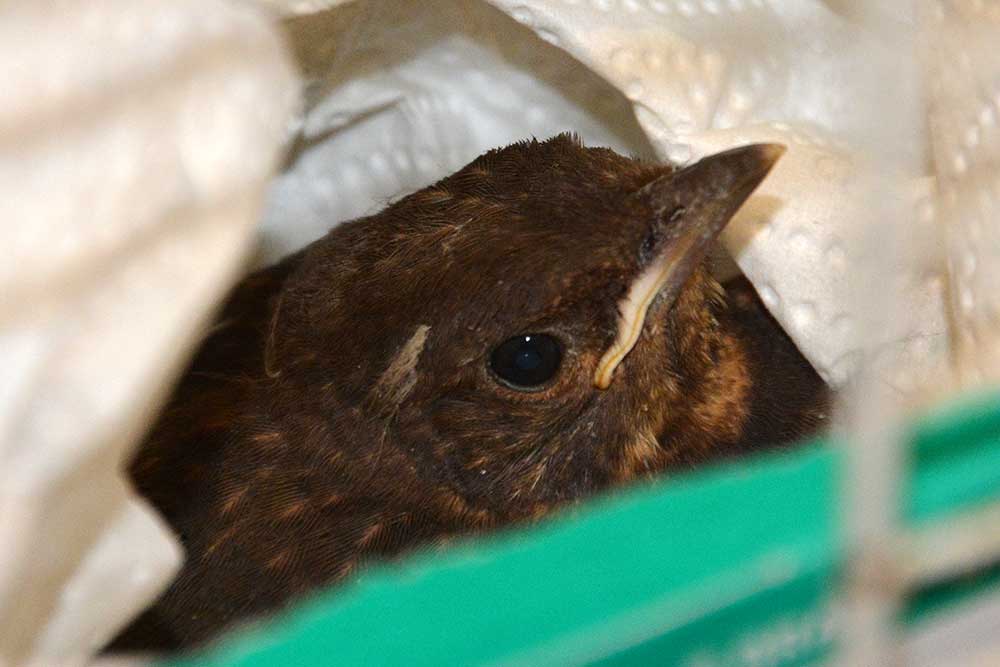
Dear readers of the English language version, you are at a disadvantage today as I did not inlcude the Facebook link that was to explain my Thursday activity in your blog on Friday. So you either have to check it out now or try answering the question all on your own.
Last Thursday I was not able to publish an issue as I had to bring a young bird to a wild bird rescue station about an hour’s drive away. The best husband of all had spotted the little fluff ball on Wednesday night and while he tried to keep the predators at bay I was able to carry the little bird inside. Thankfully it was already its usual bedtime so I did not have to worry about feeding it. Instead I had a lot of time to contact the dear ladies from the pidgeon project who – of course – recommended the wild bild rescue group on Facebook. As the best husband of all was pretty sure that Islay had at least prodded the nestling, a quick dose of an antibiotic was called for. Within 12 hours I got that sorted and the little bird was in expert hands. Identifying what kind of bird you are dealing with is very important as some birds are grain-eaters while others are insectivores and naturally you want to feed the youngster the right kind of food. But identification is sometimes not so easy. And this is your task today.
Question: Look at the above photo. What kind of bird is this?
a) Sparrow
b) Cuckoo
c) Blackbird
d) Jackdaw
————
Im Gegensatz zu den Leserinnen und Lesern der englischen Version, haben es die deutschen heute ziemlich einfach. Am letzten Freitag hatte ich im PS kurz erwähnt, dass der Grund für den Ausfall der Donnerstagsausgabe auf der Facebook-Site der Katzenparade nachzulesen sei. Wer also auf Facebook nachgeschaut hat, kann die heutige Frage mit links beantworten – oder schnell noch nachschauen.
Letzten Donnerstag war ich damit beschäftigt einen jungen Vogel zu einer Expertin der Wildvogelhilfe zu bringen, die ungefäht eine Autostunde von uns entfernt wohnt. Der beste Ehemann von allen hatte den kleinen Federball am Mittwochabend entdeckt und während er die Raubtiere fernhielt, brachte ich den Vogel ins Haus. Glücklicherweise war es bereits seine übliche Schlafenszeit, so dass ich mir erst einmal keine Gedanken über Futter machen musste. Stattdessen hatte ich genug Zeit meine Ansprechpartnerin vom Stadttaubenprojekt in Hamm um Hilfe zu bitten – und sie hatten natürlich eine Idee: die Wildvogelhilfe-Gruppe auf Facebook. Da der beste Ehemann ziemlich sicher war, dass Islay den Nestling zumindest angestubst hatte, war die Gabe eines Antibiotikums angeraten. Innerhalb von 12 Stunden konnte ich den kleinen Vogel in die Expertenhände der Wildvogelhilfe übergeben. Wenn man einen Jungvogel findet, sollte man zunächst bestimmen, um was für einen Vogel es sich eigentlich handelt, denn es gibt Insekten- und Körnerfresser und man muss ja sicherstellen, dass das Jungtier das richtige Futter bekommt. Diese Identifizierung ist manchmal gar nicht so einfach – und eure heutige Aufgabe.
Frage: Auf dem obigen Foto seht ihr den kleinen Findling. Um was für einen Vogel handelt es sich?
a) Spatz/Sperling
b) Kuckuck
c) Amsel
d) Dohle
Viel Spaß bei dieser völlig katzenfreien Ausgabe und eine tolle Woche wünscht euch
Sybilla

Amsel…
So I cheated and turned to Google images for help. Which didn’t actually help me all that much (which I’m sure serves me right). Based on the fact that it’s not black however (thus ruling out a ‚blackbird‘) and because it doesn’t look like (photos of an adult) jackdaw, I’m left with a sparrow or a cuckoo. I imagine it was trying to hop into another nest and misjudged the distance, so I’m going to go with (b) Cuckoo. 🙂